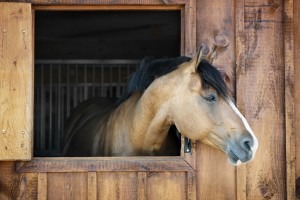Building a Barn for Your Special Needs Horses
 There are times when horses require extra medical attention, isolation, or other accommodations for special needs. Retired or aging horses may be happy with extra turnout, while a sick horse might need to be close at hand for monitoring and care.
There are times when horses require extra medical attention, isolation, or other accommodations for special needs. Retired or aging horses may be happy with extra turnout, while a sick horse might need to be close at hand for monitoring and care.
The following are some steps you can take to accommodate horses that are aging, foaling or facing other significant physical challenges. We have learned these over our decades of work as a custom horse barn builder. Read on for details!
FOALING
If you know you may have a foaling horse in your barn at any time, it makes sense to include a larger stall for that purpose in your design. A 12-by-12-foot stall is the smallest size you should consider for foaling, as a smaller stall can cause the mare to injure her foal. The larger the stall, the better. Mares should be placed at a distance from other horses or next to horses they get along with. Move the mare to the foaling stall at least 3 weeks before her due date to allow her to acclimate.
Inspect the stall carefully just as you would inspect your home before the arrival of a baby. Ensure that the stall has a good flow of fresh air, but eliminate direct drafts. Install padding over hard surfaces such as concrete footings within the stall.
In addition, you should eliminate:
- Sharp objects such as protruding nails, hooks or splinters.
- Shelves or obstacles the foal might collide with.
- Gaps that could trap a foal’s hoof.
- Dangling ropes, chains or other materials within reach that could entangle the foal.
QUARANTINED HORSES
When you need to tend a sick horse, an isolated stall will protect the affected horse as well as its barn mates. Ideally, the stall should have its own access to a small paddock to allow outdoor time without infecting other animals. Creating one large, isolated stall near the tack or storage room will give you flexibility for any horse with special needs. A corner stall will also work if the neighboring stall can be left empty. Creating a rehabilitation stall when designing your barn will make it easier to manage special needs when they arise.
RETIRED HORSES
When it comes time for a horse to retire, most owners want to give their horses a chance to kick back and just be a horse for a change. This will probably mean providing lots of opportunity to interact with their herd or with other compatible horses. It will also mean plenty of turnout time and adequate shelter from the elements. This could be provided by a “loafing shed” or a stall.
At Conestoga Buildings, we offer a variety of post frame barn and shed options that allow you to provide just the right level of care for retired horses, whether you’re starting a retirement farm exclusively for retired horses or designing a barn where your horses can age gracefully in place.
Not sure how to create a horse barn to meet your current and future needs? Contact one of our expert horse barn designers for help.
